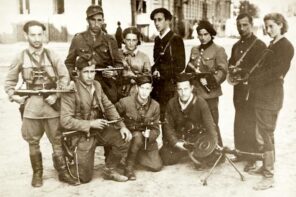The motorman of the Q-train, Terrence Legree, remembers seeing Ki-Suk Han helpless on the tracks. He saw crowds waving for him to stop the train. It was too late. “I did what I was trained to do,” he told the Daily News.
Another man was working that day: R. Umar Abassi, the freelance photographer for the New York Post who shot the scene moments before impact.
Legree triggers our feelings of compassion. Abassi sparks outrage. Lifting a camera instead of lifting a hand has turned Abassi into a symbol for the voyeur age.
That outrage may say more about us than it does about Abassi and the Post. If Abassi was indeed helpless to save a life, he wasn’t wrong to take the picture and the Post was not wrong to publish it. What they committed together was nothing more than an act of journalism—if a particularly tasteless, uncomfortable kind of journalism. He was as right in doing his job as Legree was in doing his. If there’s fault here, it’s with the whole perilous enterprise of journalism itself.
For the record, Abassi vigorously contests any shade of moral wrongdoing insisting that he never took the pictures on purpose. He was unable to help as the train barreled down the track. Events happened too fast. His photographs were an unintended consequence of using his flash to alert the conductor.
Not everyone believes this. Note, for example, the clearly incredulous Matt Lauer in his Today Show interview with Abassi. So the argument continues to rage: if he took the picture on purpose, what kind of man does that make him? And what kind of news outlet does that make the Post?
It’s the kind of least appealing, borderline case you can imagine in journalistic ethics. Yet at bottom, our calling and job description is largely to stand by while momentous things are happening. Sometimes those things are good. Sometimes they are very bad.
We don’t always just stand by. If there is, notably, the possibility to save a life, no other action is acceptable. If Abassi violated that, he deserves a black fate.
But it’s worth noting that the rest of a journalist’s work is all kinds of gray. We rely on a journalist to just stand by. She documents the dictator’s speeches and actions, but makes no assassination attempt during the interview. We expect her to report from starving countries or war zones, though every second might be better spent distributing rations or picking up a gun.
It’s a practical act of witness: while you report the story you stand in the presence, neither blinking nor stepping up.
In the world of ritual, we’re more comfortable with this behavior. Blood sacrifice, which played so great a role for Jews, Muslims, Greeks, and countless other traditions, was at its root a call to witness. That moment of sacrifice exists on the fault lines of life and death, savagery and civility. To participate, one must not intervene as something awful and important takes place. The obligation is to experience and remember.
In the real world, that inaction is rightly unsettling. Who would willingly choose to passively consort with people they may find repugnant, and situations that cry out for help? This is a journalist’s job.
And it is the editor’s job to see that witness make it into the news. You can debate that a good outlet uses those eyeballs in ways that are useful, and that a bad news outlet uses them to prey on our baser tastes for gore, sex, and voyeurism. By this measure, the Post is a bad news outlet. But it doesn’t change the fact that a death on the subway is news, the story of life as it happens, the impartial mirror we rely on to tell us the real story about ourselves. In this regard, the Post is within the larger mission of journalism to print a photo of a subway death.
If that raises our hackles, well, it should. Journalism is unsettling, on both its good and bad days. And journalists, with their studied distance, can make for awkward neighbors.
I propose that you charitably compare us to something like the role that gentiles play during Passover. A Jew can sell his chametz to a neighbor who does not observe the holiday. The neighbor’s ethical shoes fit slightly differently. And because of that, he’s able to take on an uncomfortable responsibility.
Sometimes that works out well for both of us. The world often benefits from the clear eye that sees us at our best and worst. Sometimes the results are seen as reprehensible by many. We share moments that may better be left private. Yet our forgiveness rests in this uncanny enterprise of what we set out to do: be the unflinching eyes of a world that has decided it wants to see.
[Read Rachel Wagner’s opposing opinion—“All the Wrong Reasons”—here.]




